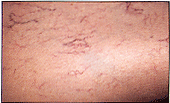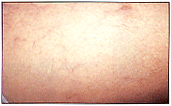Do those purple or red "spider veins" keep you from wearing shorts or a nice dress? Would you like a relatively simple, time-honored method for treatment of these leg veins?
| Did you feel like you did not want to wear shorts last summer? Do your cheek or nose veins cause your face to look dark red or purple in cold weather or with exercise? If so, treatment is just around the corner. |
| Dr. Swinehart has treated these superfluous, unnecessary leg veins for 20 years with sclerotherapy. The hypertonic saline used for this purpose has the advantage of not causing allergies. You have saline at a concentration of 0.9% in your blood stream; we use a concentration of 23.4% for sclerotherapy. Your veins are simply tubes of living cells. The saline eradicates these cells, causing the unwanted veins to disappear. Although more than one treatment may be necessary, sclerotherapy has an advantage over laser therapy in both cost and efficiency. Using a laser, the doctor has to deliver a pulse every few millimeters along each and every vein. With sclerotherapy, however, one injection into the trunk of the "tree" may cause all of the "branches" to disappear! Smaller numbers of facial veins may be treated in the office with the electric needle (cautery); the pulsed dye laser is used for larger areas of numbers of "spider veins" on the nose, cheeks, and face. |
|
 Before |
 After |
LEG VEINS |
| TREATMENT OF SPIDER VEINS ON THE LEGS |
| QUESTIONS & ANSWERS |
| DENVER DERMATOLOGY CENTER, P.C. |
| JAMES M. SWINEHART, M.D. |
| 950E. HARVARD AVE. #630 |
| DENVER, CO. 80210 |
| (303)744-1202 |
Are you dismayed by the presence of increasing numbers of unsightly, small, bluish-red or purple veins on your legs? Does this unwelcome development now prevent you from participating in activities or wearing clothes that expose these areas of your skin? Fortunately, newer, more successful techniques and methods have now made treatment of this embarassing condition possible. Often, dermatologists have noted that people who have had this done are among their mose appreciative patients. Not only can these individuals get back into athletics, swimsuit activities, and wear new fashions, but some even note that their legs don't become as tired as they did before treatment. These are the small, dialated (enlarged) veins seen frequently on the thighs, around the knees, on the calves, and around the ankles. Medically known as "telangiectasias", they are also called "star-burst varicosities", "sunburst vessels", or "broken capillaries" (actually if the vessels were really broken, they would bleed). They do not serve a purpose, but rather represent an enlargement of surface vessels secondary to increased pressure in the deeper veins. Doctors are not completely sure, but certain families seem predisposed, particularly the female relatives. Other factors suspected include: hormones, or pregnancy, prolonged sitting or standing, chemical exposure or infection, decreased local oxygen supply, or falls, blows, or other forms of physical injury. Some Authorities feel that the use of support hose may be helpful, as well as avoidance of the factors listed below. Weight reduction and exercise may also be of benefit. Treatment is performed by the technique of sclerotherapy, in which a chemical substance is injected into the unwanted veins with a tiny needle. This substance irritates and damages the lining of these small vessels, causing them to sclerose (close off) so that blood no longer flows through them. They then gradually disappear as they are absorbed by the body. A number of different injection materials is currently available, and these can be discussed more fully with your physician. A great majority of patients are very gratified, since 70% to 90% of the "spider veins" can be eventually removed if enough treatments are performed. Some vessels clear completely, and others may only lighten. Of course, perfection is not possible, and this technique will also not prevent the development of new blood vessels in the future. Each vessel often requires 2 to 3 injections. Usually the blood vessels disappear over a period of 2 weeks to 3 months. Depending on the number, size, and extent of the "spider veins", anywhere from 2 to 10 or more treatment sessions may be required. These are usually done at intervals of 2 to 3 weeks, although different sizes of the legs can be injected each week. Maintenance sessions will probably be necessary in the future as new veins appear. Most patients are good candidates for treatment. However, pregnant or nursing mothers must wait to have this done. Very large or deep varicose veins are best treated with other methods, although the small "spider veins" can still be treated by injection. Other medical conditions which make treatment difficult or impossible include: uncontrolled diabetes, some liver or kidney disease, a previous history of blood clots or thrombophlebitis (inflammation of the deep leg veins), or a past history of bad scarring, bleeding disorders, or allergy to the injection materials. Treatments by cautery with an electric needle has been done in the past. This is painful and can often leave many small, white, dot-like scars. Argon or carbon dioxide lasers have been used by some physicians, but they may also cause small, pitted, depressed or pigmented scars to remain. Very large veins can be removed with surgical techniques. That varies with your coverage. We do not accept assignment for the sessions, and appreciate payment at the time each service is rendered. Yes - the very thin, red, mat-like radiating vessels, with a "slapped cheek" appearance, can recur. However, these represent less than 1% of the vessels treated. ARE THERE RISKS? With any cosmetic procedure there are always risks. Immediately after the injection, some swelling, itching, stinging, redness and tenderness may be present. There is usually some bruising, which can last from one to several weeks - in other words, they often "look worse before they get better". In some instances a brownish stain (pigmentation) may be present at the site of the shots or along the vein, especially with larger vessels. This usually fades within 6 months. Other uncommon side effects include: allergic reactions to the medicine, infection, numbness, or fibrosis (scarring). It is possible to develo a sore or blister where the medication goes into the skin. If a small crust of skin sloughs off, a small white mark may occasionally result. In larger veins, a linear surface clot may develop until it is absorbed by the body. Of course, other or new blood vessels may appear, and further treatments may be needed in the future. Moisturizers or dry skin creams should not be used on the legs for 24 hours prior to the visit, since they get in the way and will have to be removed. It is advisable to wear shorts or a bathing suit under a full skirt of culottes, or loose slacks. If possible - avoid tight-fitting clothes. Since alcohol will be used on the skin, it is best not to shave the legs for 48 hours before the procedure. It is best to avoid excessive heat, prolonged sitting or standing, and strenious exercise such as aerobics, for the first 48 hours after treatment. During this period, leg evaluation while sitting is recommended. The best results are often obtained by wearing special compression hosiery almost continuously for the first 48 hours, and as much as possible for the three weeks following treatment. This hosiery lessens the number of treatments necessary, reduces discomfort, swelling, and bruising after treatment, and has long-term benefits such as prevention of the development of new vessels and reappearance of old ones, and prevntion of inflammation of leg veins (thrombophlebitis). Don't be surprised if:
Sclerotherapy, the best single treatment for unwanted small "spider veins" on the legs, has been used successfully for decades. Now, when these bluish-purple blood vessels appear, it is reassuring to know that this condition doesn't have to be permanent. This is not an easy or overnight cure, but thousands of patients have been pleased to see the unsightly leg veins vanish. |